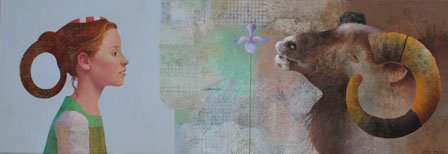The present grows out of myth and history
A warm vein of agelessness Mediterranean culture runs through Dorina Mocan's world of pictures; the worn urn against a Pompeii red wall surface. The young woman's classic, clean-cut profile. The steps that climb straight up through the overgrown garden - all breathe stillness, lucidity and agelessness.
It's easy to feel at ease in this classical tradition, in the total peacefulness, the spare compositions with large, clean surfaces in pleasant contrast to the few exquisitely worked details.
But there is always a feeling of suspense, that which raises curiosity and cannot be explained - just the indispensable, without which a work of art lacks life. Where do the mysterious steps lead to and why is there a key on one of the steps? The bird that has flown from his cage on the wall, is it happy or does it long to return? What do the horns that surround the girl, or the shells in her hair, signify?
I feel more and more convinced that a deep symbolism is hidden in Dorina Mocan's paintings. No detail is there at random, everything serves a purpose in this rich visual magic.
And yet she does not lead us into a buried, museum world. With small indications she creates a depth reaching far beyond the apparent serenity. The present grows out of myth and history.
There's life and growth by the worn out steps in the overgrown garden, while the fossils imprinted in the steps signify the continuation of life. The steps were built a long time ago and someone was here just yesterday; the key, which lies forgotten on the lowest step, has a little label with the number 2000 on it.
Just as tranquil though relentless, does the urgent force of life break out from her Pompeii inspired portrait of young girls; candid and with expectant frankness do they gaze at me, so clearly of today that I get the impression that I have just seen them in the street - and at the same time incorporated in some deep, mythical context, conjured up by the fantastic horn decorations in their hair or by the abundant vegetation.
It is just this feature of burlesque absurdity that feels refreshingly un-Swedish and typical for Dorina Mocan, who is born in Romania and came to Sweden in 1982. Luckily she has not, as an artist, felt compelled to any kind of flattened out assimilation, but has retained her own distinctive character - a successful combination of classic schooling and a vivid and clear-sighted imagination.
How this can be activated by sudden external impulses can be seen when she tells about her first meeting with a herd of rams on Gotland, and island in Sweden known for it's medieval touch, where she now lives and works parts of the year. Quite unexpectedly, the sheep rushed over a field towards her and took her back to the Romania of her childhood, and it's most beautiful ballad, which is about a shepherd and his sheep.
And so the sheep from Gotland and the limestone fossil shells frequently recur in her work, where they combine with a prehistoric world of imagination - perhaps most strikingly in the magnificent triptych "On My Right Side" with the main theme of a young woman, flanked by two impressive rams with twisted horns.
Here reality ties up with all the mystery and ambiguity found in Dorina Mocan's work, all gathered in an almost sacred, harmonious triad. The girl in the middle of the picture has a face resembling a Madonna from the renaissance, but out of her head grows an animal's horn, representing fertility and sensuality, and the artistically plaited hair is formed like a shell - the love symbol of Aphrodite's.
But Dorina Mocan's paintings are not pastiches - her girl figure may have roots found in the depth of history. In her splendid, red dress, she is alive as the green leaf beside her on the wall and the chestnuts, swollen and ripe, which are just about to burst through their shells.
Inger Landström - art critic
